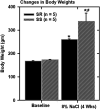High Salt Upregulates Ca2+-Sensing Receptor Expression and Ca2+-Induced Relaxation of Contracted Mesenteric Arteries from Dahl Salt-Sensitive Rats
- PMID: 35306475
- PMCID: PMC9048267
- DOI: 10.1124/jpet.121.001034
High Salt Upregulates Ca2+-Sensing Receptor Expression and Ca2+-Induced Relaxation of Contracted Mesenteric Arteries from Dahl Salt-Sensitive Rats
Abstract
High Ca2+ lowers blood pressure in hypertension, but the mechanism is not clear. The missing link may be the perivascular sensory nerve Ca2+-sensing receptor (CaSR) that mediates a vasodilator system after activation by interstitial Ca2+ Our results show that high salt increased CaSR expression in mesenteric arteries as well as Ca2+ relaxation of contracted mesenteric arteries from salt-sensitive (SS) rats. The CaSR was expressed as a doublet (≈120-150 kDa) in arteries from animals fed a high-salt diet for 1-4 weeks. The higher molecular weight glycosylated protein increased in arteries from SS animals; however, expression of the low molecular mass high-mannose protein decreased over 4 weeks of feeding the diet. In tissues from salt-resistant (SR) rats, the diet decreased CaSR expression after 4 weeks. Ca2+ relaxation of mesenteric arteries under phenylephrine tone increased in SS rats but decreased in arteries from SR rats fed the high-salt diet. Ca2+-activated K+ channels have a larger role in Ca2+ relaxation of arteries in SR than SS rats. The data suggest that high salt epigenetically regulates the receptor at the translational level in vivo and that the in vitro effect of Ca2+ is on receptor trafficking and signaling. In conclusion, upregulated expression of the CaSR in salt sensitivity increased receptor-mediated vascular relaxation. These findings show that CaSR signaling may compensate for changes in the vasculature in salt-sensitive hypertension. SIGNIFICANCE STATEMENT: The perivascular sensory nerve Ca2+-sensing receptor (CaSR) mediates Ca2+ relaxation of isolated mesenteric arteries under tension. This receptor may therefore play a significant role in relaxation of resistance arteries in vivo, thus explaining the blood pressure-lowering effect of dietary Ca2+. The present studies describe the effect of high salt-induced upregulation of the CaSR in salt-sensitive rats and the roles played by Ca2+-activated K+ channels and nitric oxide in Ca2+ responses.
Copyright © 2022 by The American Society for Pharmacology and Experimental Therapeutics.
Figures











Similar articles
-
Protein Kinase C Downregulation Enhanced Extracellular Ca2+-Induced Relaxation of Isolated Mesenteric Arteries from Aged Dahl Salt-Sensitive Rats.J Pharmacol Exp Ther. 2019 Sep;370(3):427-435. doi: 10.1124/jpet.119.258475. Epub 2019 Jun 13. J Pharmacol Exp Ther. 2019. PMID: 31197021 Free PMC article.
-
Nitric-oxide synthase knockout modulates Ca²⁺-sensing receptor expression and signaling in mouse mesenteric arteries.J Pharmacol Exp Ther. 2013 Jul;346(1):38-47. doi: 10.1124/jpet.113.205534. Epub 2013 May 2. J Pharmacol Exp Ther. 2013. PMID: 23639802 Free PMC article.
-
Amelioration of salt-induced vascular dysfunction in mesenteric arteries of Dahl salt-sensitive rats by missense mutation of extracellular superoxide dismutase.Am J Physiol Heart Circ Physiol. 2014 Feb;306(3):H339-47. doi: 10.1152/ajpheart.00619.2012. Epub 2013 Dec 6. Am J Physiol Heart Circ Physiol. 2014. PMID: 24322611 Free PMC article.
-
Role of the adenosine(2A) receptor-epoxyeicosatrienoic acid pathway in the development of salt-sensitive hypertension.Prostaglandins Other Lipid Mediat. 2012 Aug;98(3-4):39-47. doi: 10.1016/j.prostaglandins.2011.12.002. Epub 2011 Dec 22. Prostaglandins Other Lipid Mediat. 2012. PMID: 22227265 Free PMC article. Review.
-
Role of the calcium-sensing receptor in regulating vascular function.J Cell Commun Signal. 2025 Feb 5;19(1):e70004. doi: 10.1002/ccs3.70004. eCollection 2025 Mar. J Cell Commun Signal. 2025. PMID: 39912052 Free PMC article. Review.
Cited by
-
Salt Restriction and Angiotensin-Converting Enzyme Inhibitor Improve the Responsiveness of the Small Artery in Salt-Sensitive Hypertension.Int J Med Sci. 2023 Mar 5;20(5):572-580. doi: 10.7150/ijms.79741. eCollection 2023. Int J Med Sci. 2023. PMID: 37082725 Free PMC article.
References
-
- Akita S, Sacks FM, Svetkey LP, Conlin PR, Kimura G; DASH-Sodium Trial Collaborative Research Group (2003) Effects of the Dietary Approaches to Stop Hypertension (DASH) diet on the pressure-natriuresis relationship. Hypertension 42:8–13. - PubMed
-
- Angus JA, Wright CE (2000) Techniques to study the pharmacodynamics of isolated large and small blood vessels. J Pharmacol Toxicol Methods 44:395–407. - PubMed
-
- Appel LJ, Brands MW, Daniels SR, Karanja N, Elmer PJ, Sacks FM; American Heart Association (2006) Dietary approaches to prevent and treat hypertension: a scientific statement from the American Heart Association. Hypertension 47:296–308. - PubMed
-
- Appel LJMoore TJObarzanek EVollmer WMSvetkey LPSacks FMBray GAVogt TMCutler JAWindhauser MM, et al. ; DASH Collaborative Research Group (1997) A clinical trial of the effects of dietary patterns on blood pressure. N Engl J Med 336:1117–1124. - PubMed
Publication types
MeSH terms
Substances
Grants and funding
LinkOut - more resources
Full Text Sources
Medical
Research Materials
Miscellaneous

